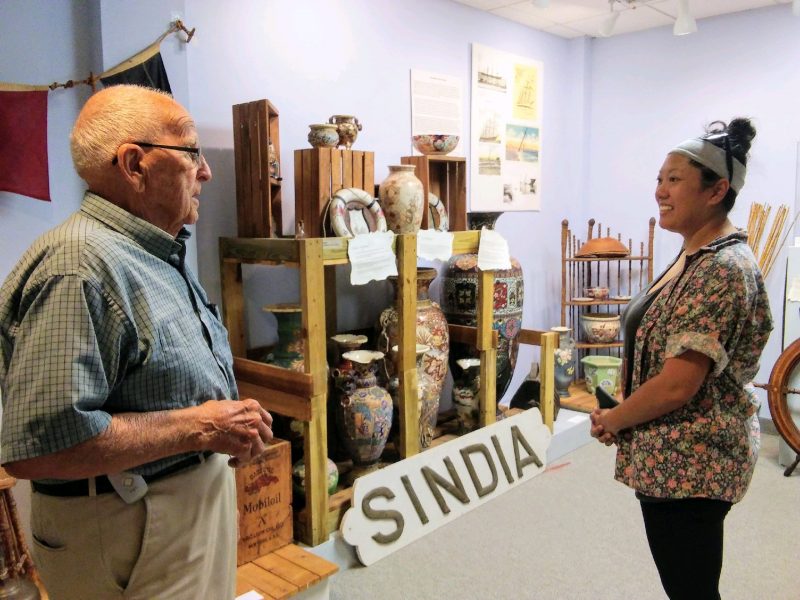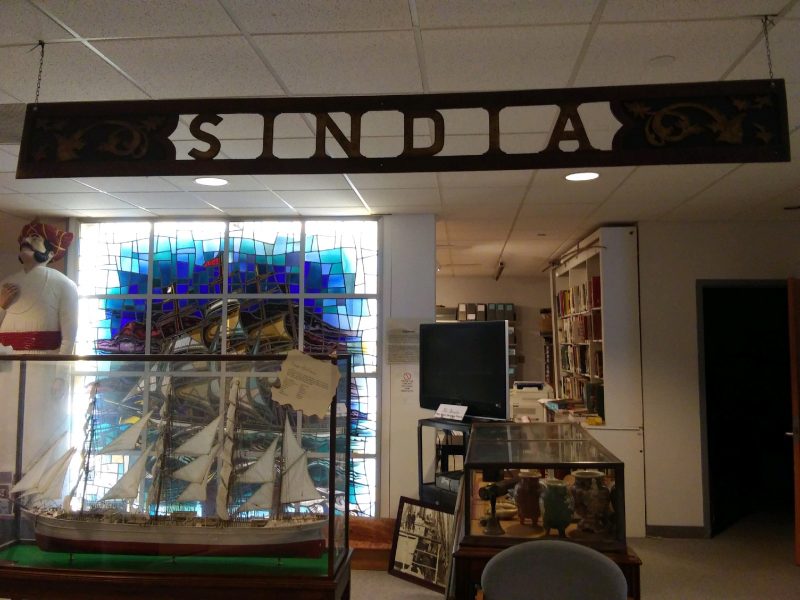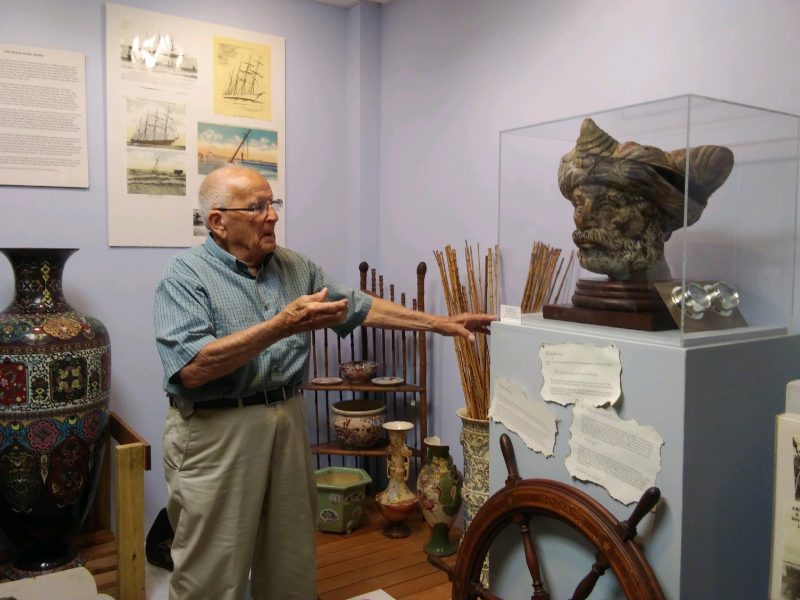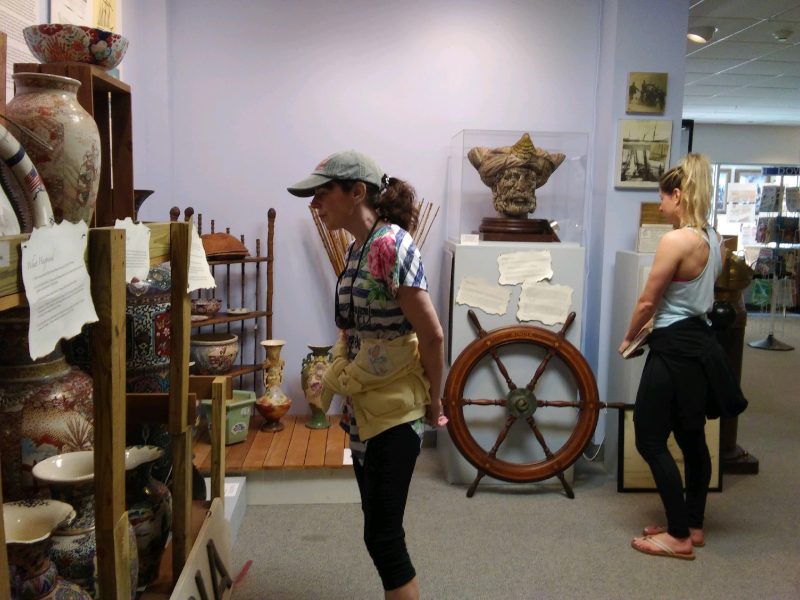 By Maddy Vitale
The iconic Sindia shipwreck exhibit at the Ocean City Historical Museum was tucked away from view.
For those who didn’t venture to the middle of the museum, they might miss it.
Dim lighting made it difficult to take in the beauty and magnificence of some of the artifacts that came off the vessel so long ago.
But now, with some rearranging, new display cases, brighter lights and a bit of restaging, the cargo ship’s artifacts are the centerpiece in a display that museum officials and patrons say really do it the justice it deserves.
By Maddy Vitale
The iconic Sindia shipwreck exhibit at the Ocean City Historical Museum was tucked away from view.
For those who didn’t venture to the middle of the museum, they might miss it.
Dim lighting made it difficult to take in the beauty and magnificence of some of the artifacts that came off the vessel so long ago.
But now, with some rearranging, new display cases, brighter lights and a bit of restaging, the cargo ship’s artifacts are the centerpiece in a display that museum officials and patrons say really do it the justice it deserves.
 Artwork in the Sindia exhibit gives museum-goers a sense of the size of the ship.
The Sindia, a 329-foot sailing ship, ran aground off Ocean City on Dec. 15, 1901. It settled not far from the beach between 16th and 17th streets. While some cargo remains buried in the sand all these years later, other pieces obtained by the museum are viewed by thousands of visitors year-round.
The revamped exhibit made its debut over Memorial Day weekend.
Paul Anselm, a historian and active member of the museum, gave OCNJDaily.com a tour of the display, pointing out some special items in the collection.
Artwork in the Sindia exhibit gives museum-goers a sense of the size of the ship.
The Sindia, a 329-foot sailing ship, ran aground off Ocean City on Dec. 15, 1901. It settled not far from the beach between 16th and 17th streets. While some cargo remains buried in the sand all these years later, other pieces obtained by the museum are viewed by thousands of visitors year-round.
The revamped exhibit made its debut over Memorial Day weekend.
Paul Anselm, a historian and active member of the museum, gave OCNJDaily.com a tour of the display, pointing out some special items in the collection.
“Now, it is the first thing people notice when they walk in the museum,” he said of the exhibit's more prominent location.

 A bell off the Sindia and some other treasured artifacts can be viewed easily at the new display.
Some cherished pieces include the ship’s brass bell, parts of the hull, the sextant and other navigational instruments and a humidor presented by the Sindia’s captain, Allan MacKenzie, to members of Ocean City’s Lake family as a thank-you gift for their help after the wreck.
Anselm walked over to a cabinet holding tall vases.
Some were pristine, others chipped, but still in great condition, considering the fact that they came off a shipwreck, he pointed out.
A curio cabinet held pieces that looked brand new and shined behind the glass covering.
“These were salvaged from the Sindia. Now that we have changed the exhibit, you can really see and appreciate them,” Anselm noted. “Before they were in the back of the museum before and it was dark.”
One museum visitor, Nitiya Sin, of Washington, D.C., was in the resort for the holiday weekend. She and her family walked around the museum and zeroed in on the Sindia exhibit.
“This is very cool. It is kind of amazing to see these pieces that were actually inside the ship,” Sin said as she looked at porcelain and pottery artifacts in the curio cabinet. “It is great to see a little snapshot of history.”
A bell off the Sindia and some other treasured artifacts can be viewed easily at the new display.
Some cherished pieces include the ship’s brass bell, parts of the hull, the sextant and other navigational instruments and a humidor presented by the Sindia’s captain, Allan MacKenzie, to members of Ocean City’s Lake family as a thank-you gift for their help after the wreck.
Anselm walked over to a cabinet holding tall vases.
Some were pristine, others chipped, but still in great condition, considering the fact that they came off a shipwreck, he pointed out.
A curio cabinet held pieces that looked brand new and shined behind the glass covering.
“These were salvaged from the Sindia. Now that we have changed the exhibit, you can really see and appreciate them,” Anselm noted. “Before they were in the back of the museum before and it was dark.”
One museum visitor, Nitiya Sin, of Washington, D.C., was in the resort for the holiday weekend. She and her family walked around the museum and zeroed in on the Sindia exhibit.
“This is very cool. It is kind of amazing to see these pieces that were actually inside the ship,” Sin said as she looked at porcelain and pottery artifacts in the curio cabinet. “It is great to see a little snapshot of history.”
 A model of the Sindia is one of the highlights of the exhibit.
A wooden sign that hangs over a portion of the exhibit also caught the attention of museum patrons.
Anselm said a person came in the museum a while back, spoke of how her grandfather was a cabin boy on the ship. She said he described the sign in detail and that it looked just like the one in the museum.
He said that type of provenance made him think it did come off the Sindia, but as a historian, he can’t say for certain.
A replica of the large figurehead that once graced the bow of the massive ship is in a corner.
The actual head of the figurehead is now behind glass. Museum workers noticed the nose looked shiny, likely the result of being touched by people.
A model of the Sindia is one of the highlights of the exhibit.
A wooden sign that hangs over a portion of the exhibit also caught the attention of museum patrons.
Anselm said a person came in the museum a while back, spoke of how her grandfather was a cabin boy on the ship. She said he described the sign in detail and that it looked just like the one in the museum.
He said that type of provenance made him think it did come off the Sindia, but as a historian, he can’t say for certain.
A replica of the large figurehead that once graced the bow of the massive ship is in a corner.
The actual head of the figurehead is now behind glass. Museum workers noticed the nose looked shiny, likely the result of being touched by people.
 The head of the figure that adorned the bow of the Sindia is all that remains and is behind glass.
A ship model shows how diminutive the figurehead was in comparison to the full size of the vessel.
“You could really see how large the Sindia was when you look at the ship model,” Anselm said.
Efforts proved futile to pull the Sindia off a sandbar when it ran aground. It served as its final resting place.
But the ship eventually broke apart. Pieces of the wreck remained visible for more than 80 years.
The head of the figure that adorned the bow of the Sindia is all that remains and is behind glass.
A ship model shows how diminutive the figurehead was in comparison to the full size of the vessel.
“You could really see how large the Sindia was when you look at the ship model,” Anselm said.
Efforts proved futile to pull the Sindia off a sandbar when it ran aground. It served as its final resting place.
But the ship eventually broke apart. Pieces of the wreck remained visible for more than 80 years.
 Jackie Scanlon, foreground, and her, Caitlyn, browse the exhibit.
Jackie Scanlon, of Philadelphia, who has a vacation home in Ocean City, knows about the Sindia. She spoke of it while she and her daughter, Caitlyn, viewed the exhibit.
“When I was a little girl, we always saw the mast of the ship,” Scanlon recalled. “We would swim around it. Everyone wanted to go see it.”
For more information about the Ocean City Historical Museum and the Sindia exhibit, call (609) 399-1801 or visit www.ocnjmuseum.org. The museum is housed inside the Ocean City Community Center, 1735 Simpson Ave.
Jackie Scanlon, foreground, and her, Caitlyn, browse the exhibit.
Jackie Scanlon, of Philadelphia, who has a vacation home in Ocean City, knows about the Sindia. She spoke of it while she and her daughter, Caitlyn, viewed the exhibit.
“When I was a little girl, we always saw the mast of the ship,” Scanlon recalled. “We would swim around it. Everyone wanted to go see it.”
For more information about the Ocean City Historical Museum and the Sindia exhibit, call (609) 399-1801 or visit www.ocnjmuseum.org. The museum is housed inside the Ocean City Community Center, 1735 Simpson Ave.